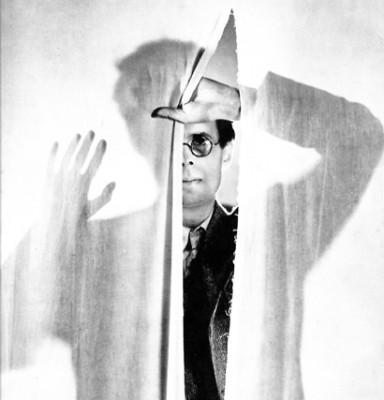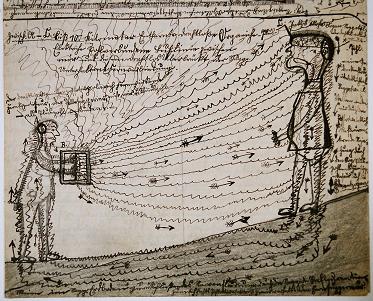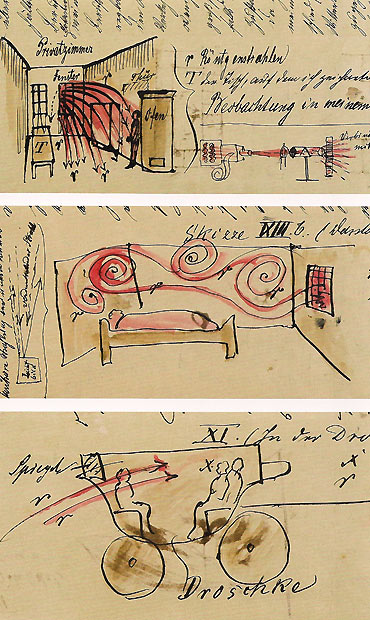
His work is comprised of dramatic mark marking, depicting the feelings brought on by such illnesses as anxiety, and more detailed paintings of a surreal theme, linking in the idea of tapping into the subconscious.

His work is comprised of dramatic mark marking, depicting the feelings brought on by such illnesses as anxiety, and more detailed paintings of a surreal theme, linking in the idea of tapping into the subconscious.
The surrealist’s aim was to unlock the unconscious mind, this often included the use of drugs and alcohol to access a “superior reality”. Surrealist theory was based on the work of Sigmund Freud, Freud argued that a concious mind exists to give us an awareness of our senses, and reflect on our sensory experience, and that the unconscious mind holds the key to what we truly feel. It is this theory that has led the path for a multitude of artists, including Henri Michaux.
Henri Michaux, a Belgian-born poet, writer, and painter. Similar to Aldous Huxley, Michaux experimented with mescaline, exploring the affects of chemical changes in the brain brought on through substances. Michaux was commissioned by the Swiss pharmaceutical company Sandoz, to produced short films to demonstrate the effects of this hallucinogenic drug.
The intense audio, and dark imagery seems to be going on a journey, taking us further and further into Michaux’s mind These films give us an eerie insight into Michaux mental state, and raise the quest of, are we seeing glimpses into Michaux’s subconscious, or just random hallucination created by mescaline?
Michaux also practised automatic drawing and writing, believing that once you remove grammatical conventions, the hand is able to express deeper thought patterns. Michaux also believed that words slowed the thought process, that we search our minds for words to communicate very individual feelings, thus creating boundaries for our expression.
I find these automatic drawing also have a resemblance to the outsider art I have been researching. Almost frantic mark making, a rushed process to portray their emotions at that exact moment.
“There is an inside to experience as well as an outside” – Aldous Huxley
Aldous Huxley, was an English writer, novelist, and philosopher, in the early 20th century he experimented with a drug called mescaline, which is is a naturally occurring psychedelic alkaloid, extracted from cacti, and processes effects similar to those of LSD.
He believed using this drug who help him to surpass the conscious and enter the subconscious, and be able to experience senses unattainable in a conscious state.

This is similar to the aims of Susan Hiller, who is an American-born artist who lives in London. Her art practice includes installation, video, photography, performance and automatic writing. Hiller has a major interest in the unconscious mind, from dreams and memories, to supernatural or visionary experiences. Though Hiller explores these subjects through unseen realms of human experience, unseen realms of experience, and not psychedelics.

Hiller calls her work “a kind of archaeological investigation, uncovering something to make a different kind of sense of it” and “concentrating on what is unspoken, unacknowledged, unexplained and overlooked.” Have been interested in the deeper meanings in art, looking at how it is being used to better understand the human condition. Giving us a tool to express that, that may not be linguistically describable.

Hiller explores the subconscious in an array of different methods, including automatic writing. In these writings, Hiller expresses a stream of words, said to be issues pushed out of the conscious mind. And often reinforcing the idea of the unconscious as a source of knowledge or truth.
Here are some of my own automatic drawings, my first attempt was quite controlled, I was very aware that I was trying not to be aware. This produced a somewhat neat drawing, everything kept within it’s boundaries. The more I did the less, I thought, which I think it clearly depicted in the mark making.
The term outsider art was coined by art critic Roger Cardinal in 1972, as the English term for Art Brut. Art Brut was a label created by French artist Jean Dubuffet to describe art created outside the boundaries of official culture. People who haven’t had any formal training within their disciplines, but have managed to create thought provoking, contemporary pieces.
I have found myself thinking about art as a physiological reflex, movements and marks symbols of our inner psyche. Outsider art is a perfect example of this, taking, for example, a mental illness and harnessing their turmoil and creating an outlet in art.
Nick Blinko, is a prime example of art a an outlet for inner turmoil. Once medicated and mentally stable, his ability to create work diminishes. His extremely detailed pieces give us an insight into his mental instability, with often then pieces seeming really noisy/ busy.
JJ Cromer, a once a librarian, became obsessed with drawing in later life, the objects he grew up around, his families collection of rocks, bugs, plants, and animals have all become subject matter for his work. Is this an unconscious move to revert back to his childhood?



In my research into outsider artist, I have noticed a similarity between a large amount of artists. Large scale works, extremely detailed and controlled imagery, usually a lot going on without one single focus point. Is this a representation of their mental state? With each exhibiting similar work, could it be that these outcomes are similar to symptoms?
Examples –
Adolf Wolfli
Winfred Rembert
Kate Bradbury
Does mental illness make more sense in colour and shape than words? How do we recognise abstract pieces of work as a particular emotion. Have we been taught to express through words and not with all ranges of tools at hand? I have been researching Hans Prinzhorn, a psychiatrist from the early 20th century. He believed art was an invaluable tool into understanding the inner mind, and created an alphabet of marks and shapes which he believed belong to certain emotions.

August Natterer (1868 – 1933), a schizophrenic German outsider artist, Prinzhorn Collection, Heidelberg

